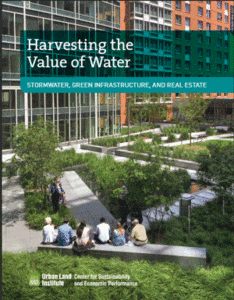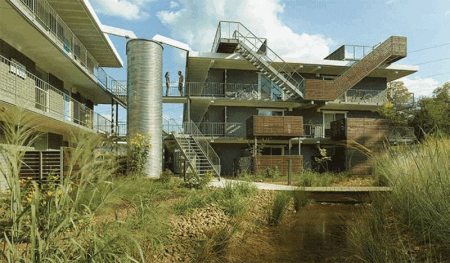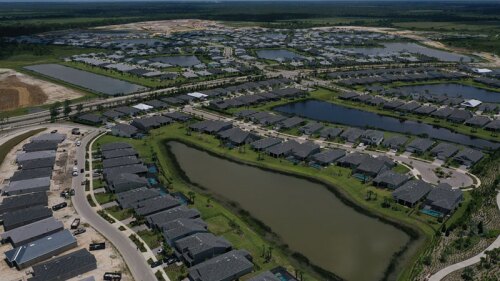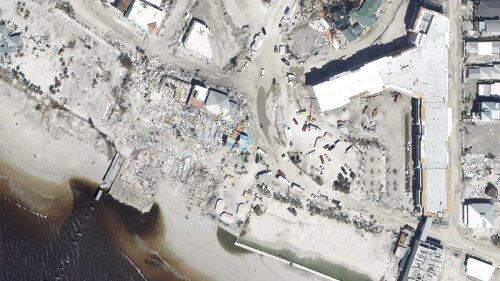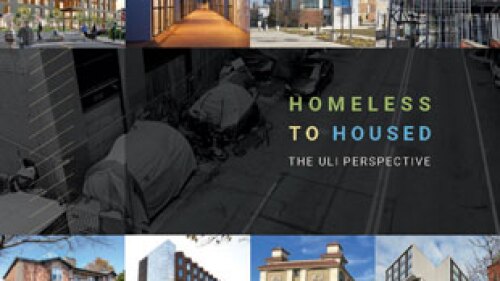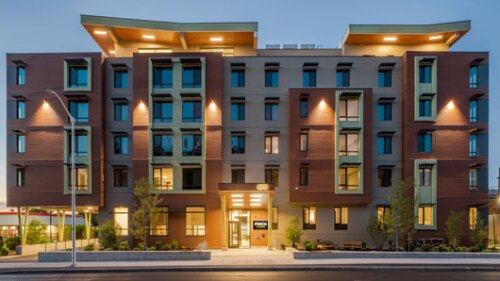The growing involvement of the real estate industry in helping municipalities manage stormwater runoff with systems using natural resources is explored in a new ULI publication, Harvesting the Value of Water: Stormwater, Green Infrastructure, and Real Estate .
The report, released at ULI’s 2017 Spring Meeting in Seattle, looks at how water management mechanisms using green infrastructure can create value for real estate projects by improving operational efficiency as well as serving as an attractive amenity. Green infrastructure, explains the report, includes pipes-and-pumps alternatives such as rain gardens, bioswales, and green roofs, which are often accompanied by water storage and recycling tools such as cisterns. These types of sustainable stormwater management practices can provide health benefits for building users as well as benefits for the environment in general.
“The development community is addressing the challenge of stormwater management with creative solutions that are not only conserving water, but also adding value and appeal to real estate projects across the nation,” said Katharine Burgess, ULI’s Urban Resilience Program director, who directed the research.
Harvesting the Value of Water points out that while using green infrastructure to capture stormwater is not new, what is new is that a rising number of local governments are creating coordinated citywide green infrastructure networks including both public and private properties. Many real estate developers are responding to new regulations by incorporating the requirements into their business models, it notes. “Whether by increasing potential development yield, introducing tangible amenities for residents, reducing operating costs, or building on a broader placemaking strategy, innovative stormwater management strategies can create value and contribute to the quality of life and resilience in cities,” the report says.
While the U.S. Environmental Protection Agency oversees federal standards for water quality and management, local approaches to stormwater management vary widely due to different market conditions, annual rainfalls, and climate challenges, notes the report. However, despite the differences in how stormwater is managed, several common themes are emerging from green infrastructure approaches that involve the real estate community. These include:
- Green infrastructure offers cities opportunities to enhance environmental performance and save money, compared with costly gray infrastructure projects that do not offer other community benefits.
- Green infrastructure can offer real estate developers opportunities for cost savings by freeing up more developable land than traditional water management solutions.
- Green infrastructure can enhance the attractiveness and value of a property and reduce operating costs.
- The emerging range of green infrastructure policies and strategies works in different markets and contexts.
- Green infrastructure may require an initial learning curve, but the payoff can be worth the effort, in terms of improved amenities, aesthetics, and marketing appeal.
- Real estate owners and operators value green infrastructure’s performance during peak weather events and the added security it brings to their investments.
Harvesting the Value of Water includes case studies of several U.S. real estate projects in which the use of green infrastructure is generating added value:
- Atlantic Wharf, Boston, Massachusetts—a 31-story office, retail, and residential development, often referred to as Boston’s first “green skyscraper,” with an innovative stormwater management system;
- Burbank Water and Power EcoCampus, Burbank, California—a campus for a community-owned utility site that is powered solely by recycled water;
- Canal Park, Washington, D.C.—a neighborhood park developed by a public/private partnership and located on the site of a former city waterway, with 95 percent of the water used for irrigation, water fountains, and other purposes provided through rainwater recycling;
- Encore!, Tampa, Florida—a public/private mixed-use development with an 8,000-square-foot (743 sq m) stormwater retention harvesting system and a stormwater vault designed as the centerpiece of a public park;
- High Point, Seattle, Washington—the Seattle Housing Authority’s largest residential project (1,700 affordable and market-rate homes), featuring an extensive natural drainage system with bioswales and constructed wetlands;
- Market at Colonnade, Raleigh, North Carolina—a 57,000-square-foot (5,300 sq m) commercial development that can capture up to 800,000 gallons (3 million liters) of rainwater, including placement of a visible cistern outside a Whole Foods Market as part of the grocer’s branding strategy;
- Meier & Frank Delivery Depot, Portland, Oregon—an office development in a National Register of Historic Places building with a rainwater recycling system that saves an estimated 193,000 gallons (731,000 liters) of water annually;
- Penn Park, Philadelphia, Pennsylvania—a community open space developed by the University of Pennsylvania through a public/private partnership and designed in response to the city’s Green City, Clean Waters plan and the university’s climate action plan;
- Stonebrook Estates, Harris County, Texas—a Houston-area residential development with a low-impact development approach that withstood major flooding in 2016;
- The Avenue, Washington, D.C.—a mixed-use, transit-oriented development in downtown Washington featuring a robust stormwater management system incorporated into a residential courtyard; and
- The Rose, Minneapolis, Minnesota—a 90-unit, mixed-income residential project designed for on-site stormwater treatment, including a rain garden and cisterns.
Harvesting the Value of Water was published with a grant from the Kresge Foundation, which is providing generous support for ULI’s work in promoting sustainable, resilient, and healthy communities.

